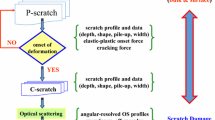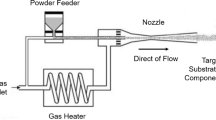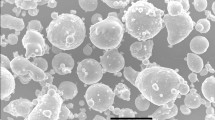Abstract
Sag is a coating defect that results from excessive, gravity-driven flow after deposition. Accordingly, characterizing resistance to sag is critically important. In this paper, sag resistance predicted using a multinotched applicator test is compared with results obtained using an in situ particle tracking technique that measures surface velocity. Four commercial latex paints dried on substrates inclined at three angles were investigated. The results are used to provide insight into the strengths and limitations of using a multinotched applicator to evaluate sag resistance. For coatings dried on vertical surfaces (90°), the suggested condition for the multinotched applicator, sag lengths found by particle tracking show differences between paints that the multinotched applicator ranked as identical. At smaller angles (e.g., 10°), the resolution of the multinotched applicator test is greatly enhanced owing to a reduction in the shear stress difference between adjacent coated lines. Based on these results, specific recommendations are made for successfully employing a multinotched applicator to evaluate sag resistance based on user-specific goals.






Similar content being viewed by others
References
Patton, T, Paint Flow and Pigment Dispersion, 2nd ed., pp. 98–107, 553–563, 581–584. Wiley, New York (1964)
Wicks Jr., ZW, Jones, FN, Pappas, SP, Wicks, DA, “Film Defects.” In: Organic Coatings: Science and Technology, p. 498. Wiley, Hoboken, (2006)
Schwartz, LW, Eley, RR, “Flow of Architectural Coatings on Complex Surfaces; Theory and Experiment.” J. Eng. Math, 43 153–171 (2002)
Troian, SM, Herbolzheimer, E, Safran, SA, Joanny, JF, “Fingering Instabilities of Driven Spreading Films.” Europhys. Lett., 10 25–30 (1989)
Croll, SG, Kisha, LW, “Observations of Sagging in Architectural Paints.” Prog. Org. Coat., 20 27–52 (1992)
Gutoff, E, Cohen, E, Coating and Drying Defects: Troubleshooting Operating Problems, 2nd ed., pp. 94–95, 107. Wiley, Hoboken (2006)
Overdiep, WS, “The Effect of a Reduced Solvent Content of Solventborne Solution Paints on Film Formation.” Prog. Org. Coat., 14 1–21 (1986)
Colclough, M, Smith, NDP, Wright, TA, “A Low Shear Viscometer: An Instrument for Measuring Flow and Sag Resistance in Coatings.” J. Oil Col. Chem. Assoc., 63 183–193 (1980)
Wu, S, “Rheology of High Solid Coatings. I. Analysis of Sagging and Slumping.” J. Appl. Polym. Sci., 22 2769–2782 (1978)
Frisch, HL, Scopazzi, C, “Sag Equation for Coatings on Rotating Substrates.” J. Appl. Polym. Sci., 43 1067–1070 (1991)
Bosma, M, Brinkhuis, R, Coopmans, J, Reuvers, B, “The Role of Sag Control Agents in Optimizing the Sag/Leveling Balance and a New Powerful Tool to Study This.” Prog. Org. Coat., 55 97–104 (2006)
Bosma, M, Brinkhuis, R, Rensen, E, Watson, R, “A New Method for the Quantitative Determination and Prediction of Sag and Levelling in Powder Coatings.” Prog. Org. Coat., 72 26–33 (2011)
Song, J-O, “In Situ Characterization of Dynamic Structures of Coatings.” Ph.D. Dissertation, University of Minnesota Twin Cities, Minneapolis (2012)
Lade Jr., RK, Song, J-O, Musliner, AD, Williams, BA, Kumar, S, Macosko, CW, Francis, LF, “Sag in Drying Coatings: Prediction and Real Time Measurement with Particle Tracking.” Submitted to Prog. Org. Coat., 86 49–58 (2015)
Patton, T, “A Simple Pigment-Settling Gage and A Simple Anti-Sag Test.” Off. Dig. Fed. Paint Varn. Prod. Clubs, 29 10–25 (1957)
Hancock, HE, “Description and Evaluation of the Kansas City Club Sag Tester.” Off. Dig. Fed. Paint Varn. Prod. Clubs, 29 1086–1093 (1957)
Reynolds, W, Larson, E, “New Tool for Evaluating Sagging of Paint.” Paint Varn. Prod., 48 31–34 (1958)
Schaeffer, L, “Design of an Improved Sag Tester.” Off. Dig. Fed. Soc. Paint Technol., 34 1110–1123 (1962)
Leneta Co. Catalog No. 6—Revised, “Test Charts & Test Equipment for the Paint and Coatings Industry,” Leneta Co., Mahwah, p. 35 (2014)
ASTM Standard D4400—99(2012)e1, 2012, “Standard Test Method for Sag Resistance of Paints Using a Multinotch Applicator,” ASTM International, West Conshohocken, DOI: 10.1520/D440-00R12E01, www.astm.org (2012)
Miller, DG, Moll, WF, Taylor, VW, “Rheology Control of High Solids Coatings.” Based on a paper presented at the Annual Meeting of the Federation of Societies for Coatings Technology, Washington, (1982)
Schaeffer, L, “Interlaboratory Study to Establish Precision Statements for ASTM D4400-99(2007) Standard Test Method for Sag Resistance of Paints Using a Multinotch Applicator.” (1984)
Khan, SA, Schnepper, CA, Armstrong, RC, “Foam Rheology: III. Measurement of Shear Flow Properties.” J. Rheol., 32 69–92 (1988)
Sbalzarini, IF, Koumoutsakos, P, “Feature Point Tracking and Trajectory Analysis for Video Imaging in Cell Biology.” J. Struct. Biol., 151 182–195 (2005)
Sullivan, T, Middleman, S, “Film Thickness in Blade Coating of Viscous and Viscoelastic Liquids.” J. NonNewton. Fluid Mech., 21 13–38 (1986)
Acknowledgments
The authors thank the industrial supporters of the Coating Process Fundamentals Program (CPFP) of the Industrial Partnership for Research in Interfacial and Materials Engineering (IPRIME) for supporting this research. The authors extend their gratitude to Keith Kirkwood at The Valspar Corporation in Minneapolis, Minnesota, for providing an Anti-Sag Meter and for insightful discussions regarding its use. The authors would also like to thank Wieslaw Suszynski for designing the inclined drying stage and for many helpful discussions.
Author information
Authors and Affiliations
Corresponding author
Additional information
This paper was presented at the 17th International Coating Science and Technology Symposium, September 7–10, 2014, in San Diego, CA (USA).
Rights and permissions
About this article
Cite this article
Lade, R.K., Musliner, A.D., Macosko, C.W. et al. Evaluating sag resistance with a multinotched applicator: correlation with surface flow measurements and practical recommendations. J Coat Technol Res 12, 809–817 (2015). https://doi.org/10.1007/s11998-015-9680-5
Published:
Issue Date:
DOI: https://doi.org/10.1007/s11998-015-9680-5




